5G New Radio in Wireless Communication
VerifiedAdded on 2023/04/22
|12
|3714
|455
AI Summary
This article discusses the advantages and disadvantages of 5G New Radio in wireless communication. It explores the key features of 5G New Radio, including new radio spectrum, optimized OFDM, beamforming, MIMO, spectrum sharing techniques, a unified design across frequencies, and small cells. The article also covers the key patterns and relationships in 5G New Radio, such as MIMO and antenna inference, dual connectivity, and uplink carrier aggregation. Finally, the article compares 5G technology with older technology.
Contribute Materials
Your contribution can guide someone’s learning journey. Share your
documents today.

5G NEW RADIO IN WIRELESS COMMUNICATION
INTRODUCTION
5G technology is known as 5th Generation mobile technology. A new version called new radio changes mobile communication with high
bandwidth. The advanced interfaces used on 5G will make mobile communication more effective and reliable. The packet switched access is
converted to orthogonal frequency division spectrum that will increase the coverage area, provide high bandwidth, frequency and throughput in
the form of mm waves (millimetre waves i.e. 10 cm to 1mm) (Nayana and Milu Hanna Mathew 2018), (Akhil Gupta 2015).
5G NEW RADIO
The cellular network has a mobile communication standard called 5G new radio interfaces and information related to the radio network, which is
used to get more connectivity between the mobiles. The main advantages of the n5G New Radio interface is it allows the 5D mobile
communication network to provide more users than 4G technology permits (Bhushan 2014) (Sharma 2014).
5G new radios use a modulation, waveforms and techniques for accessing which will permit the network system to achieve a high data rate
services. These are useful for the user who needs a less latency, minimum data rates and long battery life. The development of 5G new radio is to
provide flexibility, scalability, efficiency in both spectrum and power usage. These techniques on 5G will provide a high bandwidth
communication on transmission in streaming videos, low latency communication for remote access control and minimum data rate with low
bandwidth for machine type communication. (Bangerter, 2014), (VidhiVashist 2015).
Consider a recently released Samsung galaxy S10 device as an example for 5G technology. They are equipped with Snapdragon 855 chipset
which is enabled with x50 modem. This is responsible for the 5g connectivity. It uses bands with 28GHZ, which can be used for mobile devices.
Previously, point to point fixed lines were used but now we can use the band for our mobile devices. This process can be achieved with the help
of new antenna technology. It has 10 antenna system where 4 of them works with millimetre waves. The antenna can cover 360 degrees i.e there
is no problem with the position of the phone whereas beamforming is used to target at the specific user and track all the user with silicon
processing (Nayana and Milu Hanna Mathew 2018).
INTRODUCTION
5G technology is known as 5th Generation mobile technology. A new version called new radio changes mobile communication with high
bandwidth. The advanced interfaces used on 5G will make mobile communication more effective and reliable. The packet switched access is
converted to orthogonal frequency division spectrum that will increase the coverage area, provide high bandwidth, frequency and throughput in
the form of mm waves (millimetre waves i.e. 10 cm to 1mm) (Nayana and Milu Hanna Mathew 2018), (Akhil Gupta 2015).
5G NEW RADIO
The cellular network has a mobile communication standard called 5G new radio interfaces and information related to the radio network, which is
used to get more connectivity between the mobiles. The main advantages of the n5G New Radio interface is it allows the 5D mobile
communication network to provide more users than 4G technology permits (Bhushan 2014) (Sharma 2014).
5G new radios use a modulation, waveforms and techniques for accessing which will permit the network system to achieve a high data rate
services. These are useful for the user who needs a less latency, minimum data rates and long battery life. The development of 5G new radio is to
provide flexibility, scalability, efficiency in both spectrum and power usage. These techniques on 5G will provide a high bandwidth
communication on transmission in streaming videos, low latency communication for remote access control and minimum data rate with low
bandwidth for machine type communication. (Bangerter, 2014), (VidhiVashist 2015).
Consider a recently released Samsung galaxy S10 device as an example for 5G technology. They are equipped with Snapdragon 855 chipset
which is enabled with x50 modem. This is responsible for the 5g connectivity. It uses bands with 28GHZ, which can be used for mobile devices.
Previously, point to point fixed lines were used but now we can use the band for our mobile devices. This process can be achieved with the help
of new antenna technology. It has 10 antenna system where 4 of them works with millimetre waves. The antenna can cover 360 degrees i.e there
is no problem with the position of the phone whereas beamforming is used to target at the specific user and track all the user with silicon
processing (Nayana and Milu Hanna Mathew 2018).
Secure Best Marks with AI Grader
Need help grading? Try our AI Grader for instant feedback on your assignments.

CONCEPTS USED IN A 5G NEW RADIO
New radio spectrum
Optimized OFDM
Beamforming
MIMO
Spectrum sharing techniques
A unified design across frequencies
Small cells
New Radio Spectrum
The mobile communication is increasing rapidly and the benefits of 5G technology will increase the further use of mobile communication for
many applications that holds 5G technology. The improvement in spectrum efficiency will increase the use of 5G technology. The use of a
higher frequency band will allow higher signal bandwidth to the network by supporting high data rates and throughput. The shorter range in this
technology will allow the frequency re-use (Sapakal 2013).
Optimized OFDM
Orthogonal frequency division modulation OFDM waveform is used in the phase of the 5G new radio interfaces. Like 4G now 5G also uses the
optimized form of modulation to get more efficiency. This optimized waveform in orthogonal frequency division spectrum will increase the
significance of the connection. The downlink waveform used in 5G new radio is cyclic prefix OFDM. CP-OFDM and some other special version
of LTE are also adopted in the downlink signal (Electronic-notes 2019).
Beam forming
Beam forming is a technology that provides significant advantages to 5G technology. This will allows the beam in the base station to link
directly to the mobiles. Doing this an optimum signal can be transmitted to the mobile and can be received from it. This will give the high
frequency that can be passed to the small antennas. If an antenna receives high frequencies then the smaller antenna will give a high-frequency
performance on beam steering which will give the exact power to the mobiles (Electronic-notes 2019).
New radio spectrum
Optimized OFDM
Beamforming
MIMO
Spectrum sharing techniques
A unified design across frequencies
Small cells
New Radio Spectrum
The mobile communication is increasing rapidly and the benefits of 5G technology will increase the further use of mobile communication for
many applications that holds 5G technology. The improvement in spectrum efficiency will increase the use of 5G technology. The use of a
higher frequency band will allow higher signal bandwidth to the network by supporting high data rates and throughput. The shorter range in this
technology will allow the frequency re-use (Sapakal 2013).
Optimized OFDM
Orthogonal frequency division modulation OFDM waveform is used in the phase of the 5G new radio interfaces. Like 4G now 5G also uses the
optimized form of modulation to get more efficiency. This optimized waveform in orthogonal frequency division spectrum will increase the
significance of the connection. The downlink waveform used in 5G new radio is cyclic prefix OFDM. CP-OFDM and some other special version
of LTE are also adopted in the downlink signal (Electronic-notes 2019).
Beam forming
Beam forming is a technology that provides significant advantages to 5G technology. This will allows the beam in the base station to link
directly to the mobiles. Doing this an optimum signal can be transmitted to the mobile and can be received from it. This will give the high
frequency that can be passed to the small antennas. If an antenna receives high frequencies then the smaller antenna will give a high-frequency
performance on beam steering which will give the exact power to the mobiles (Electronic-notes 2019).
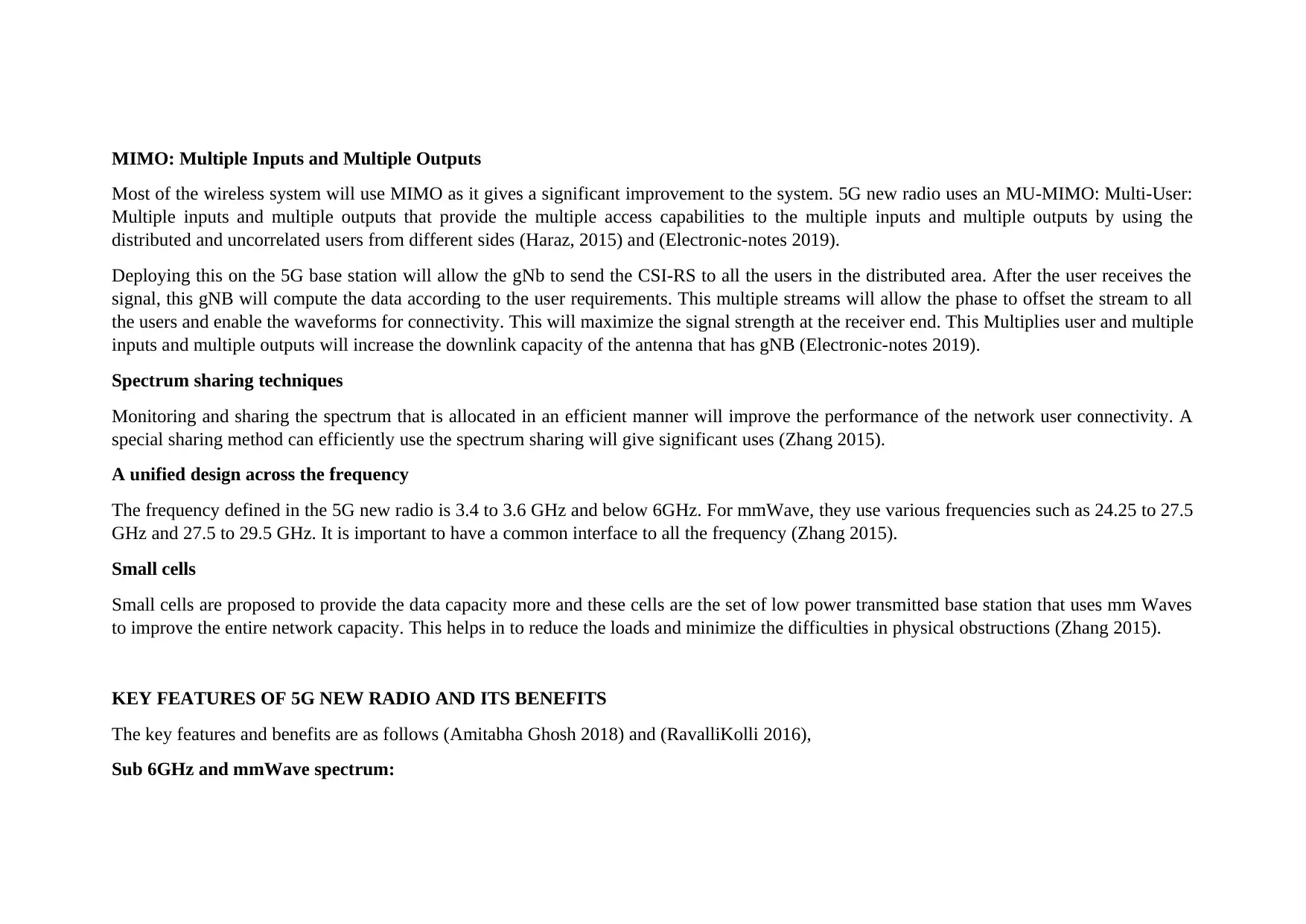
MIMO: Multiple Inputs and Multiple Outputs
Most of the wireless system will use MIMO as it gives a significant improvement to the system. 5G new radio uses an MU-MIMO: Multi-User:
Multiple inputs and multiple outputs that provide the multiple access capabilities to the multiple inputs and multiple outputs by using the
distributed and uncorrelated users from different sides (Haraz, 2015) and (Electronic-notes 2019).
Deploying this on the 5G base station will allow the gNb to send the CSI-RS to all the users in the distributed area. After the user receives the
signal, this gNB will compute the data according to the user requirements. This multiple streams will allow the phase to offset the stream to all
the users and enable the waveforms for connectivity. This will maximize the signal strength at the receiver end. This Multiplies user and multiple
inputs and multiple outputs will increase the downlink capacity of the antenna that has gNB (Electronic-notes 2019).
Spectrum sharing techniques
Monitoring and sharing the spectrum that is allocated in an efficient manner will improve the performance of the network user connectivity. A
special sharing method can efficiently use the spectrum sharing will give significant uses (Zhang 2015).
A unified design across the frequency
The frequency defined in the 5G new radio is 3.4 to 3.6 GHz and below 6GHz. For mmWave, they use various frequencies such as 24.25 to 27.5
GHz and 27.5 to 29.5 GHz. It is important to have a common interface to all the frequency (Zhang 2015).
Small cells
Small cells are proposed to provide the data capacity more and these cells are the set of low power transmitted base station that uses mm Waves
to improve the entire network capacity. This helps in to reduce the loads and minimize the difficulties in physical obstructions (Zhang 2015).
KEY FEATURES OF 5G NEW RADIO AND ITS BENEFITS
The key features and benefits are as follows (Amitabha Ghosh 2018) and (RavalliKolli 2016),
Sub 6GHz and mmWave spectrum:
Most of the wireless system will use MIMO as it gives a significant improvement to the system. 5G new radio uses an MU-MIMO: Multi-User:
Multiple inputs and multiple outputs that provide the multiple access capabilities to the multiple inputs and multiple outputs by using the
distributed and uncorrelated users from different sides (Haraz, 2015) and (Electronic-notes 2019).
Deploying this on the 5G base station will allow the gNb to send the CSI-RS to all the users in the distributed area. After the user receives the
signal, this gNB will compute the data according to the user requirements. This multiple streams will allow the phase to offset the stream to all
the users and enable the waveforms for connectivity. This will maximize the signal strength at the receiver end. This Multiplies user and multiple
inputs and multiple outputs will increase the downlink capacity of the antenna that has gNB (Electronic-notes 2019).
Spectrum sharing techniques
Monitoring and sharing the spectrum that is allocated in an efficient manner will improve the performance of the network user connectivity. A
special sharing method can efficiently use the spectrum sharing will give significant uses (Zhang 2015).
A unified design across the frequency
The frequency defined in the 5G new radio is 3.4 to 3.6 GHz and below 6GHz. For mmWave, they use various frequencies such as 24.25 to 27.5
GHz and 27.5 to 29.5 GHz. It is important to have a common interface to all the frequency (Zhang 2015).
Small cells
Small cells are proposed to provide the data capacity more and these cells are the set of low power transmitted base station that uses mm Waves
to improve the entire network capacity. This helps in to reduce the loads and minimize the difficulties in physical obstructions (Zhang 2015).
KEY FEATURES OF 5G NEW RADIO AND ITS BENEFITS
The key features and benefits are as follows (Amitabha Ghosh 2018) and (RavalliKolli 2016),
Sub 6GHz and mmWave spectrum:
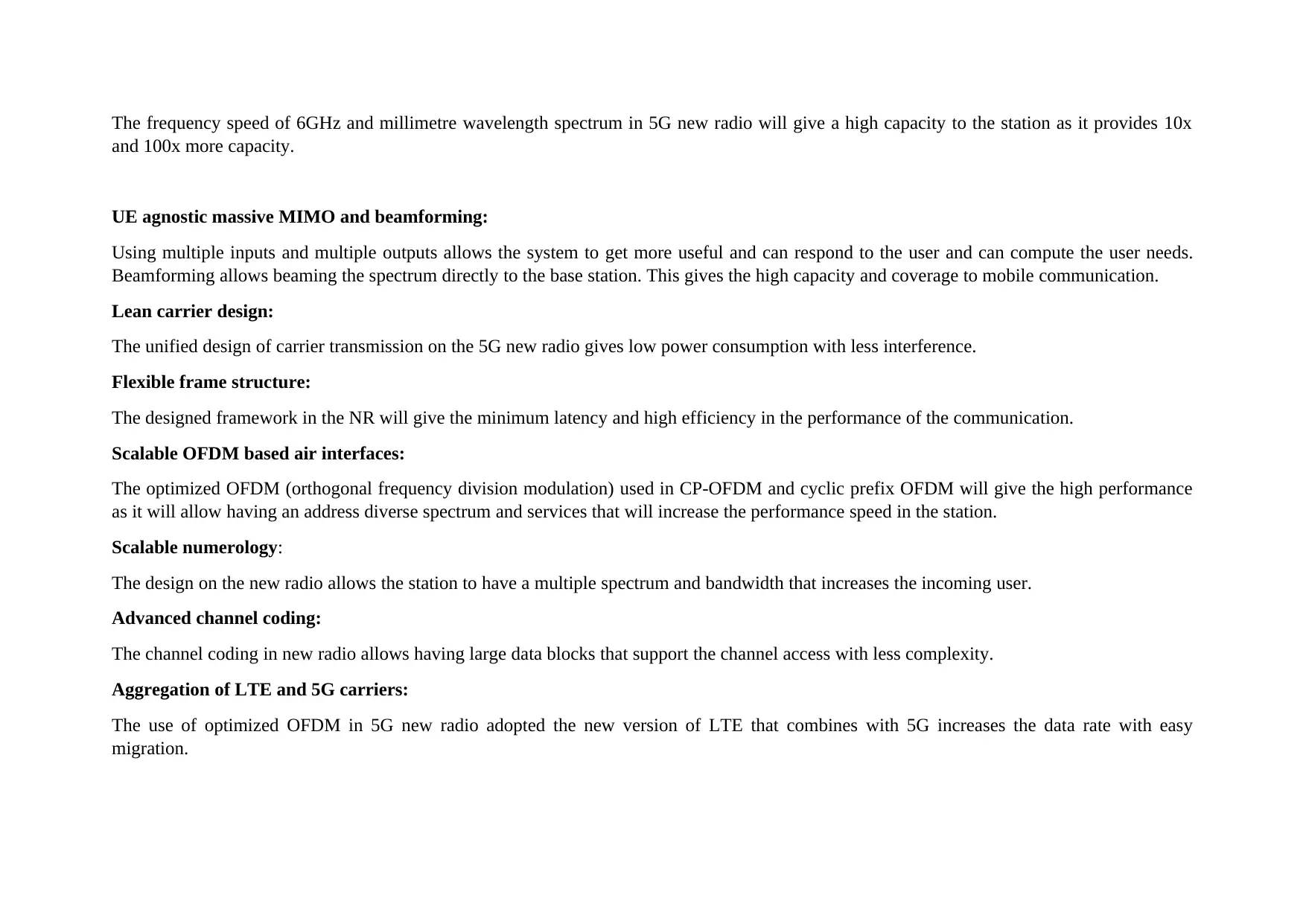
The frequency speed of 6GHz and millimetre wavelength spectrum in 5G new radio will give a high capacity to the station as it provides 10x
and 100x more capacity.
UE agnostic massive MIMO and beamforming:
Using multiple inputs and multiple outputs allows the system to get more useful and can respond to the user and can compute the user needs.
Beamforming allows beaming the spectrum directly to the base station. This gives the high capacity and coverage to mobile communication.
Lean carrier design:
The unified design of carrier transmission on the 5G new radio gives low power consumption with less interference.
Flexible frame structure:
The designed framework in the NR will give the minimum latency and high efficiency in the performance of the communication.
Scalable OFDM based air interfaces:
The optimized OFDM (orthogonal frequency division modulation) used in CP-OFDM and cyclic prefix OFDM will give the high performance
as it will allow having an address diverse spectrum and services that will increase the performance speed in the station.
Scalable numerology:
The design on the new radio allows the station to have a multiple spectrum and bandwidth that increases the incoming user.
Advanced channel coding:
The channel coding in new radio allows having large data blocks that support the channel access with less complexity.
Aggregation of LTE and 5G carriers:
The use of optimized OFDM in 5G new radio adopted the new version of LTE that combines with 5G increases the data rate with easy
migration.
and 100x more capacity.
UE agnostic massive MIMO and beamforming:
Using multiple inputs and multiple outputs allows the system to get more useful and can respond to the user and can compute the user needs.
Beamforming allows beaming the spectrum directly to the base station. This gives the high capacity and coverage to mobile communication.
Lean carrier design:
The unified design of carrier transmission on the 5G new radio gives low power consumption with less interference.
Flexible frame structure:
The designed framework in the NR will give the minimum latency and high efficiency in the performance of the communication.
Scalable OFDM based air interfaces:
The optimized OFDM (orthogonal frequency division modulation) used in CP-OFDM and cyclic prefix OFDM will give the high performance
as it will allow having an address diverse spectrum and services that will increase the performance speed in the station.
Scalable numerology:
The design on the new radio allows the station to have a multiple spectrum and bandwidth that increases the incoming user.
Advanced channel coding:
The channel coding in new radio allows having large data blocks that support the channel access with less complexity.
Aggregation of LTE and 5G carriers:
The use of optimized OFDM in 5G new radio adopted the new version of LTE that combines with 5G increases the data rate with easy
migration.
Secure Best Marks with AI Grader
Need help grading? Try our AI Grader for instant feedback on your assignments.
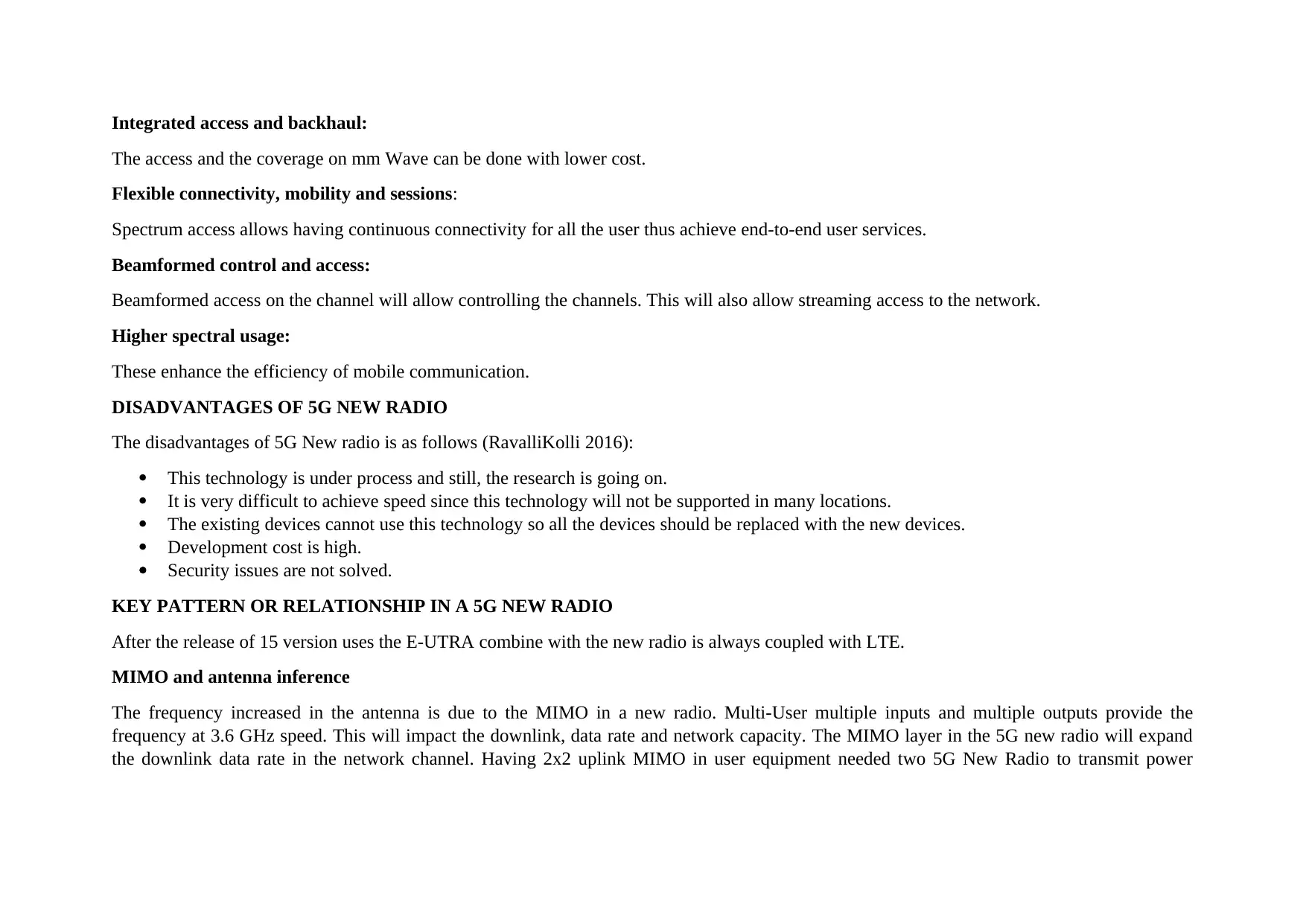
Integrated access and backhaul:
The access and the coverage on mm Wave can be done with lower cost.
Flexible connectivity, mobility and sessions:
Spectrum access allows having continuous connectivity for all the user thus achieve end-to-end user services.
Beamformed control and access:
Beamformed access on the channel will allow controlling the channels. This will also allow streaming access to the network.
Higher spectral usage:
These enhance the efficiency of mobile communication.
DISADVANTAGES OF 5G NEW RADIO
The disadvantages of 5G New radio is as follows (RavalliKolli 2016):
This technology is under process and still, the research is going on.
It is very difficult to achieve speed since this technology will not be supported in many locations.
The existing devices cannot use this technology so all the devices should be replaced with the new devices.
Development cost is high.
Security issues are not solved.
KEY PATTERN OR RELATIONSHIP IN A 5G NEW RADIO
After the release of 15 version uses the E-UTRA combine with the new radio is always coupled with LTE.
MIMO and antenna inference
The frequency increased in the antenna is due to the MIMO in a new radio. Multi-User multiple inputs and multiple outputs provide the
frequency at 3.6 GHz speed. This will impact the downlink, data rate and network capacity. The MIMO layer in the 5G new radio will expand
the downlink data rate in the network channel. Having 2x2 uplink MIMO in user equipment needed two 5G New Radio to transmit power
The access and the coverage on mm Wave can be done with lower cost.
Flexible connectivity, mobility and sessions:
Spectrum access allows having continuous connectivity for all the user thus achieve end-to-end user services.
Beamformed control and access:
Beamformed access on the channel will allow controlling the channels. This will also allow streaming access to the network.
Higher spectral usage:
These enhance the efficiency of mobile communication.
DISADVANTAGES OF 5G NEW RADIO
The disadvantages of 5G New radio is as follows (RavalliKolli 2016):
This technology is under process and still, the research is going on.
It is very difficult to achieve speed since this technology will not be supported in many locations.
The existing devices cannot use this technology so all the devices should be replaced with the new devices.
Development cost is high.
Security issues are not solved.
KEY PATTERN OR RELATIONSHIP IN A 5G NEW RADIO
After the release of 15 version uses the E-UTRA combine with the new radio is always coupled with LTE.
MIMO and antenna inference
The frequency increased in the antenna is due to the MIMO in a new radio. Multi-User multiple inputs and multiple outputs provide the
frequency at 3.6 GHz speed. This will impact the downlink, data rate and network capacity. The MIMO layer in the 5G new radio will expand
the downlink data rate in the network channel. Having 2x2 uplink MIMO in user equipment needed two 5G New Radio to transmit power
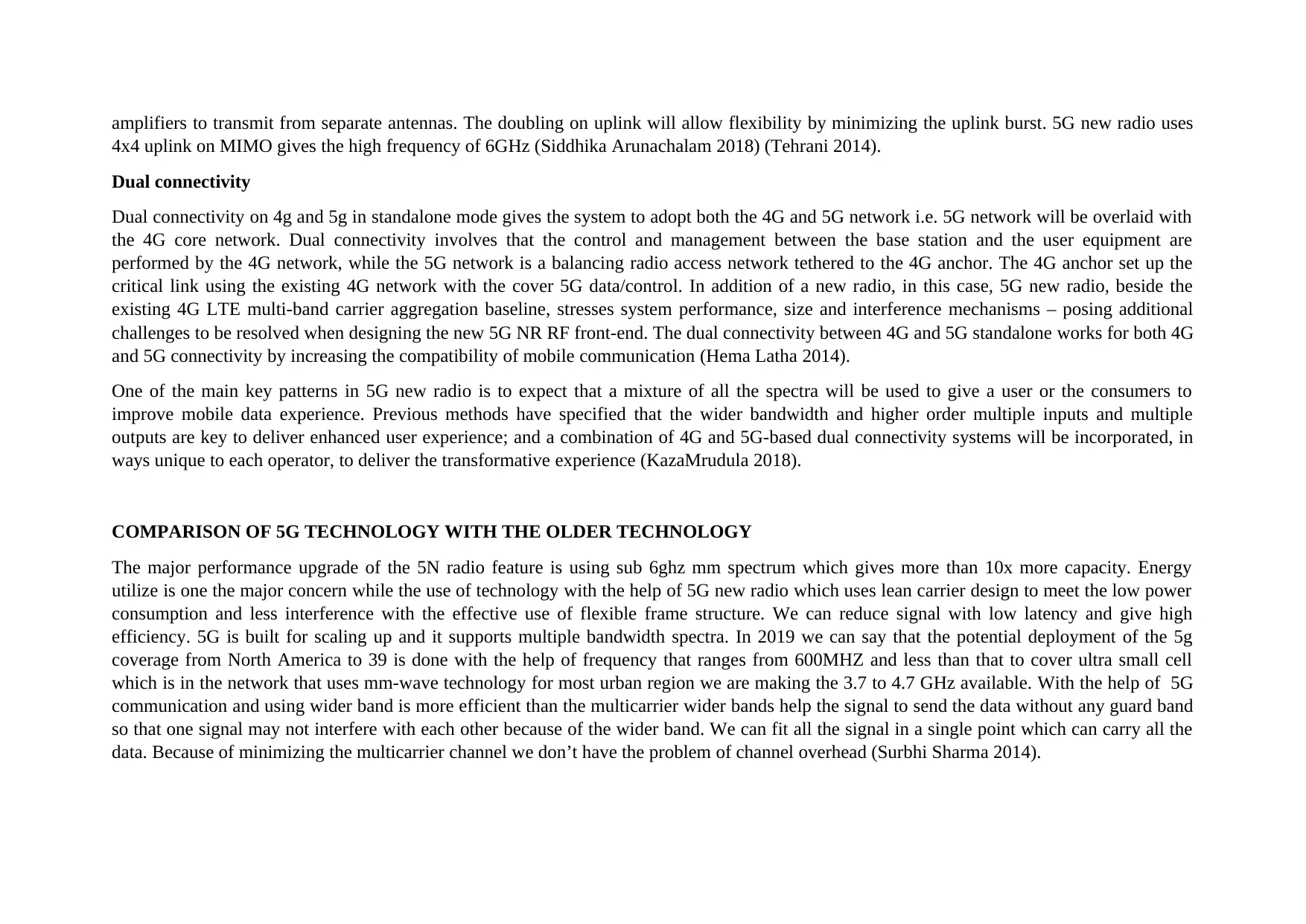
amplifiers to transmit from separate antennas. The doubling on uplink will allow flexibility by minimizing the uplink burst. 5G new radio uses
4x4 uplink on MIMO gives the high frequency of 6GHz (Siddhika Arunachalam 2018) (Tehrani 2014).
Dual connectivity
Dual connectivity on 4g and 5g in standalone mode gives the system to adopt both the 4G and 5G network i.e. 5G network will be overlaid with
the 4G core network. Dual connectivity involves that the control and management between the base station and the user equipment are
performed by the 4G network, while the 5G network is a balancing radio access network tethered to the 4G anchor. The 4G anchor set up the
critical link using the existing 4G network with the cover 5G data/control. In addition of a new radio, in this case, 5G new radio, beside the
existing 4G LTE multi-band carrier aggregation baseline, stresses system performance, size and interference mechanisms – posing additional
challenges to be resolved when designing the new 5G NR RF front-end. The dual connectivity between 4G and 5G standalone works for both 4G
and 5G connectivity by increasing the compatibility of mobile communication (Hema Latha 2014).
One of the main key patterns in 5G new radio is to expect that a mixture of all the spectra will be used to give a user or the consumers to
improve mobile data experience. Previous methods have specified that the wider bandwidth and higher order multiple inputs and multiple
outputs are key to deliver enhanced user experience; and a combination of 4G and 5G-based dual connectivity systems will be incorporated, in
ways unique to each operator, to deliver the transformative experience (KazaMrudula 2018).
COMPARISON OF 5G TECHNOLOGY WITH THE OLDER TECHNOLOGY
The major performance upgrade of the 5N radio feature is using sub 6ghz mm spectrum which gives more than 10x more capacity. Energy
utilize is one the major concern while the use of technology with the help of 5G new radio which uses lean carrier design to meet the low power
consumption and less interference with the effective use of flexible frame structure. We can reduce signal with low latency and give high
efficiency. 5G is built for scaling up and it supports multiple bandwidth spectra. In 2019 we can say that the potential deployment of the 5g
coverage from North America to 39 is done with the help of frequency that ranges from 600MHZ and less than that to cover ultra small cell
which is in the network that uses mm-wave technology for most urban region we are making the 3.7 to 4.7 GHz available. With the help of 5G
communication and using wider band is more efficient than the multicarrier wider bands help the signal to send the data without any guard band
so that one signal may not interfere with each other because of the wider band. We can fit all the signal in a single point which can carry all the
data. Because of minimizing the multicarrier channel we don’t have the problem of channel overhead (Surbhi Sharma 2014).
4x4 uplink on MIMO gives the high frequency of 6GHz (Siddhika Arunachalam 2018) (Tehrani 2014).
Dual connectivity
Dual connectivity on 4g and 5g in standalone mode gives the system to adopt both the 4G and 5G network i.e. 5G network will be overlaid with
the 4G core network. Dual connectivity involves that the control and management between the base station and the user equipment are
performed by the 4G network, while the 5G network is a balancing radio access network tethered to the 4G anchor. The 4G anchor set up the
critical link using the existing 4G network with the cover 5G data/control. In addition of a new radio, in this case, 5G new radio, beside the
existing 4G LTE multi-band carrier aggregation baseline, stresses system performance, size and interference mechanisms – posing additional
challenges to be resolved when designing the new 5G NR RF front-end. The dual connectivity between 4G and 5G standalone works for both 4G
and 5G connectivity by increasing the compatibility of mobile communication (Hema Latha 2014).
One of the main key patterns in 5G new radio is to expect that a mixture of all the spectra will be used to give a user or the consumers to
improve mobile data experience. Previous methods have specified that the wider bandwidth and higher order multiple inputs and multiple
outputs are key to deliver enhanced user experience; and a combination of 4G and 5G-based dual connectivity systems will be incorporated, in
ways unique to each operator, to deliver the transformative experience (KazaMrudula 2018).
COMPARISON OF 5G TECHNOLOGY WITH THE OLDER TECHNOLOGY
The major performance upgrade of the 5N radio feature is using sub 6ghz mm spectrum which gives more than 10x more capacity. Energy
utilize is one the major concern while the use of technology with the help of 5G new radio which uses lean carrier design to meet the low power
consumption and less interference with the effective use of flexible frame structure. We can reduce signal with low latency and give high
efficiency. 5G is built for scaling up and it supports multiple bandwidth spectra. In 2019 we can say that the potential deployment of the 5g
coverage from North America to 39 is done with the help of frequency that ranges from 600MHZ and less than that to cover ultra small cell
which is in the network that uses mm-wave technology for most urban region we are making the 3.7 to 4.7 GHz available. With the help of 5G
communication and using wider band is more efficient than the multicarrier wider bands help the signal to send the data without any guard band
so that one signal may not interfere with each other because of the wider band. We can fit all the signal in a single point which can carry all the
data. Because of minimizing the multicarrier channel we don’t have the problem of channel overhead (Surbhi Sharma 2014).
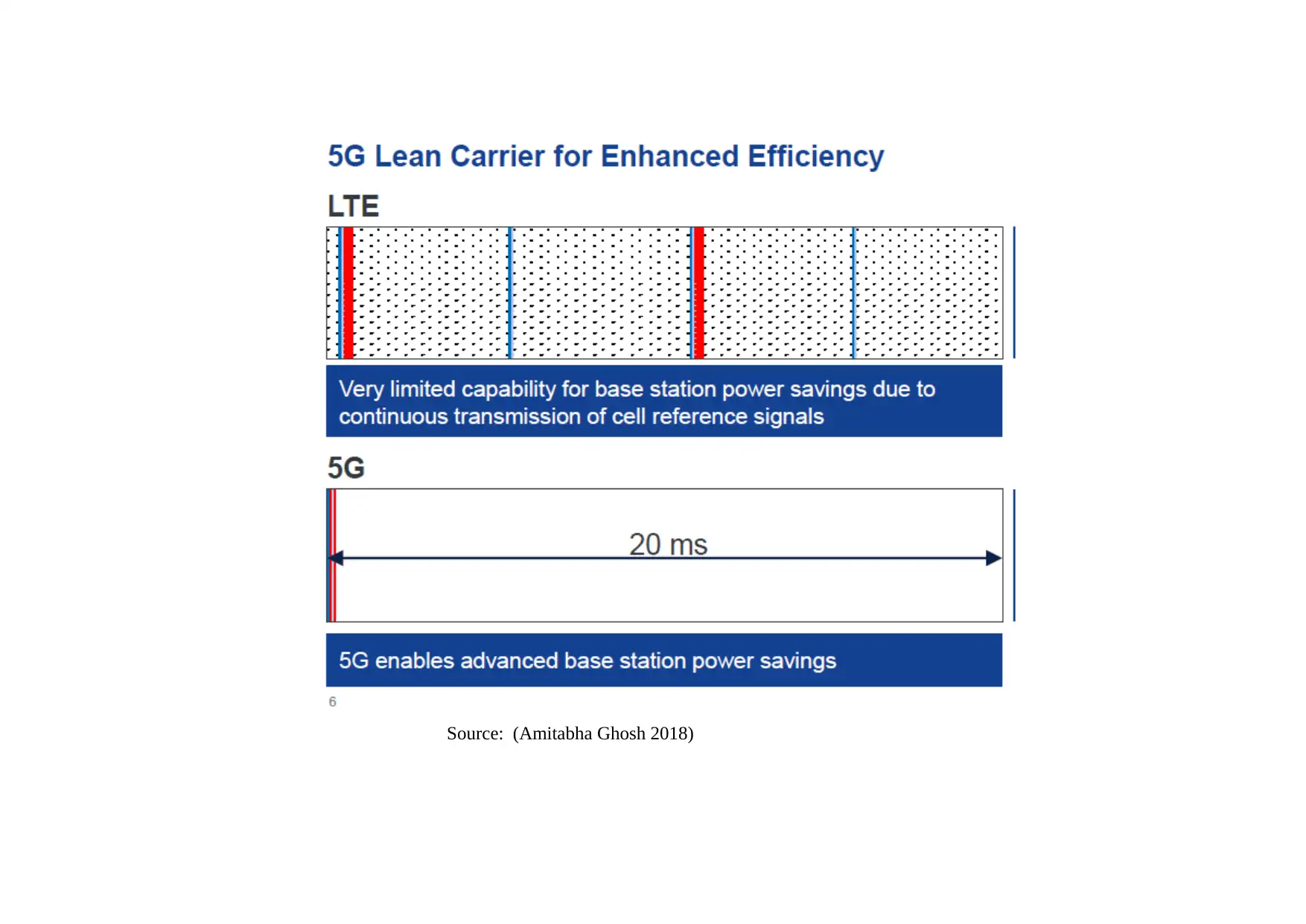
Source: (Amitabha Ghosh 2018)
Paraphrase This Document
Need a fresh take? Get an instant paraphrase of this document with our AI Paraphraser
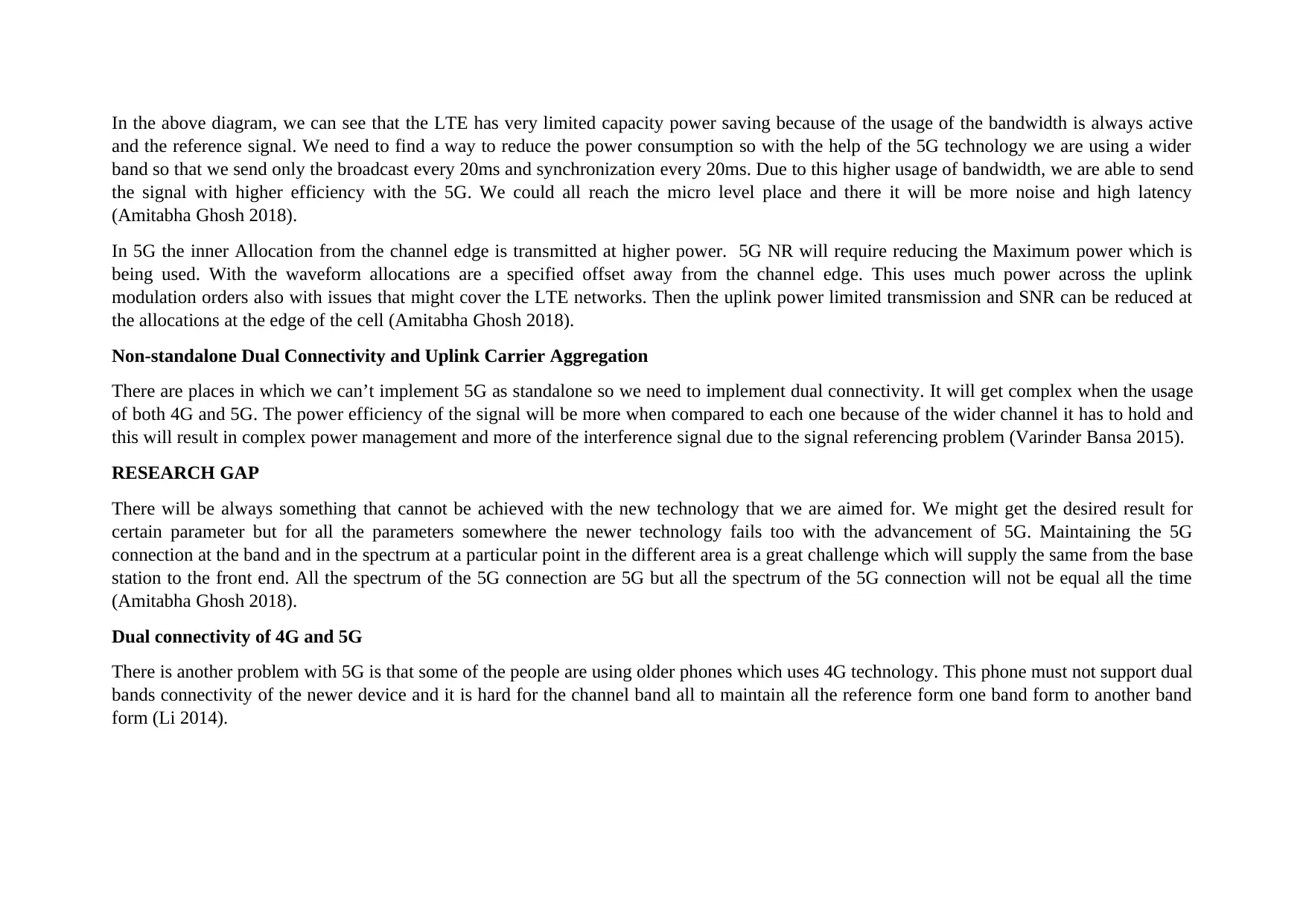
In the above diagram, we can see that the LTE has very limited capacity power saving because of the usage of the bandwidth is always active
and the reference signal. We need to find a way to reduce the power consumption so with the help of the 5G technology we are using a wider
band so that we send only the broadcast every 20ms and synchronization every 20ms. Due to this higher usage of bandwidth, we are able to send
the signal with higher efficiency with the 5G. We could all reach the micro level place and there it will be more noise and high latency
(Amitabha Ghosh 2018).
In 5G the inner Allocation from the channel edge is transmitted at higher power. 5G NR will require reducing the Maximum power which is
being used. With the waveform allocations are a specified offset away from the channel edge. This uses much power across the uplink
modulation orders also with issues that might cover the LTE networks. Then the uplink power limited transmission and SNR can be reduced at
the allocations at the edge of the cell (Amitabha Ghosh 2018).
Non-standalone Dual Connectivity and Uplink Carrier Aggregation
There are places in which we can’t implement 5G as standalone so we need to implement dual connectivity. It will get complex when the usage
of both 4G and 5G. The power efficiency of the signal will be more when compared to each one because of the wider channel it has to hold and
this will result in complex power management and more of the interference signal due to the signal referencing problem (Varinder Bansa 2015).
RESEARCH GAP
There will be always something that cannot be achieved with the new technology that we are aimed for. We might get the desired result for
certain parameter but for all the parameters somewhere the newer technology fails too with the advancement of 5G. Maintaining the 5G
connection at the band and in the spectrum at a particular point in the different area is a great challenge which will supply the same from the base
station to the front end. All the spectrum of the 5G connection are 5G but all the spectrum of the 5G connection will not be equal all the time
(Amitabha Ghosh 2018).
Dual connectivity of 4G and 5G
There is another problem with 5G is that some of the people are using older phones which uses 4G technology. This phone must not support dual
bands connectivity of the newer device and it is hard for the channel band all to maintain all the reference form one band form to another band
form (Li 2014).
and the reference signal. We need to find a way to reduce the power consumption so with the help of the 5G technology we are using a wider
band so that we send only the broadcast every 20ms and synchronization every 20ms. Due to this higher usage of bandwidth, we are able to send
the signal with higher efficiency with the 5G. We could all reach the micro level place and there it will be more noise and high latency
(Amitabha Ghosh 2018).
In 5G the inner Allocation from the channel edge is transmitted at higher power. 5G NR will require reducing the Maximum power which is
being used. With the waveform allocations are a specified offset away from the channel edge. This uses much power across the uplink
modulation orders also with issues that might cover the LTE networks. Then the uplink power limited transmission and SNR can be reduced at
the allocations at the edge of the cell (Amitabha Ghosh 2018).
Non-standalone Dual Connectivity and Uplink Carrier Aggregation
There are places in which we can’t implement 5G as standalone so we need to implement dual connectivity. It will get complex when the usage
of both 4G and 5G. The power efficiency of the signal will be more when compared to each one because of the wider channel it has to hold and
this will result in complex power management and more of the interference signal due to the signal referencing problem (Varinder Bansa 2015).
RESEARCH GAP
There will be always something that cannot be achieved with the new technology that we are aimed for. We might get the desired result for
certain parameter but for all the parameters somewhere the newer technology fails too with the advancement of 5G. Maintaining the 5G
connection at the band and in the spectrum at a particular point in the different area is a great challenge which will supply the same from the base
station to the front end. All the spectrum of the 5G connection are 5G but all the spectrum of the 5G connection will not be equal all the time
(Amitabha Ghosh 2018).
Dual connectivity of 4G and 5G
There is another problem with 5G is that some of the people are using older phones which uses 4G technology. This phone must not support dual
bands connectivity of the newer device and it is hard for the channel band all to maintain all the reference form one band form to another band
form (Li 2014).
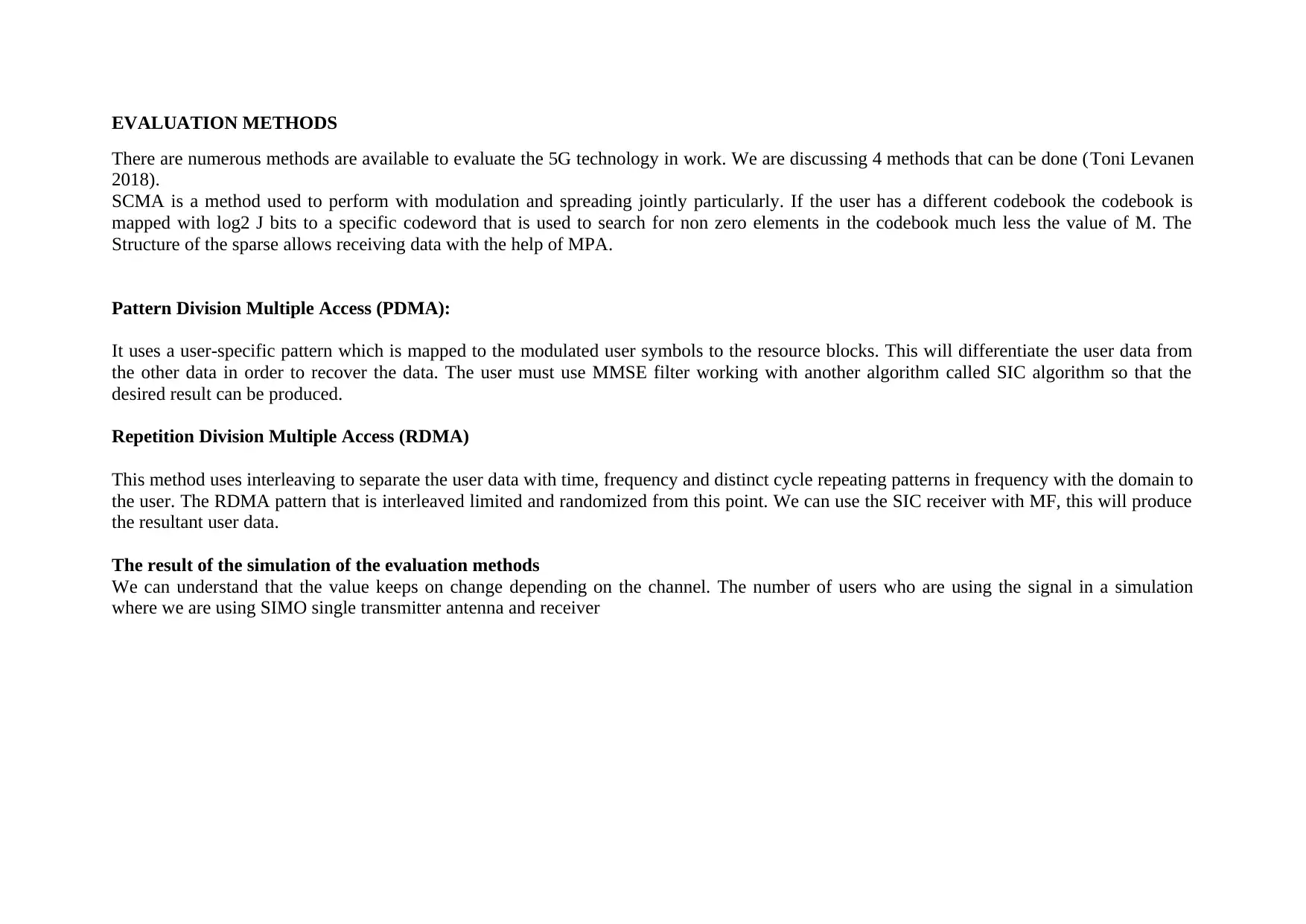
EVALUATION METHODS
There are numerous methods are available to evaluate the 5G technology in work. We are discussing 4 methods that can be done (Toni Levanen
2018).
SCMA is a method used to perform with modulation and spreading jointly particularly. If the user has a different codebook the codebook is
mapped with log2 J bits to a specific codeword that is used to search for non zero elements in the codebook much less the value of M. The
Structure of the sparse allows receiving data with the help of MPA.
Pattern Division Multiple Access (PDMA):
It uses a user-specific pattern which is mapped to the modulated user symbols to the resource blocks. This will differentiate the user data from
the other data in order to recover the data. The user must use MMSE filter working with another algorithm called SIC algorithm so that the
desired result can be produced.
Repetition Division Multiple Access (RDMA)
This method uses interleaving to separate the user data with time, frequency and distinct cycle repeating patterns in frequency with the domain to
the user. The RDMA pattern that is interleaved limited and randomized from this point. We can use the SIC receiver with MF, this will produce
the resultant user data.
The result of the simulation of the evaluation methods
We can understand that the value keeps on change depending on the channel. The number of users who are using the signal in a simulation
where we are using SIMO single transmitter antenna and receiver
There are numerous methods are available to evaluate the 5G technology in work. We are discussing 4 methods that can be done (Toni Levanen
2018).
SCMA is a method used to perform with modulation and spreading jointly particularly. If the user has a different codebook the codebook is
mapped with log2 J bits to a specific codeword that is used to search for non zero elements in the codebook much less the value of M. The
Structure of the sparse allows receiving data with the help of MPA.
Pattern Division Multiple Access (PDMA):
It uses a user-specific pattern which is mapped to the modulated user symbols to the resource blocks. This will differentiate the user data from
the other data in order to recover the data. The user must use MMSE filter working with another algorithm called SIC algorithm so that the
desired result can be produced.
Repetition Division Multiple Access (RDMA)
This method uses interleaving to separate the user data with time, frequency and distinct cycle repeating patterns in frequency with the domain to
the user. The RDMA pattern that is interleaved limited and randomized from this point. We can use the SIC receiver with MF, this will produce
the resultant user data.
The result of the simulation of the evaluation methods
We can understand that the value keeps on change depending on the channel. The number of users who are using the signal in a simulation
where we are using SIMO single transmitter antenna and receiver

Source: (Toni Levanen 2018).
CONCLUSION
Thus we have tried multiple access technologies that are used in 5G new radio connection. We have done research on key feature and structure
categorization of 5G though link level simulation. The amount of data that is sent in the channel might be affected by the characteristics of
different types of signatures and receiving algorithms that are used in the link communication from one signal to another signal.
CONCLUSION
Thus we have tried multiple access technologies that are used in 5G new radio connection. We have done research on key feature and structure
categorization of 5G though link level simulation. The amount of data that is sent in the channel might be affected by the characteristics of
different types of signatures and receiving algorithms that are used in the link communication from one signal to another signal.
Secure Best Marks with AI Grader
Need help grading? Try our AI Grader for instant feedback on your assignments.
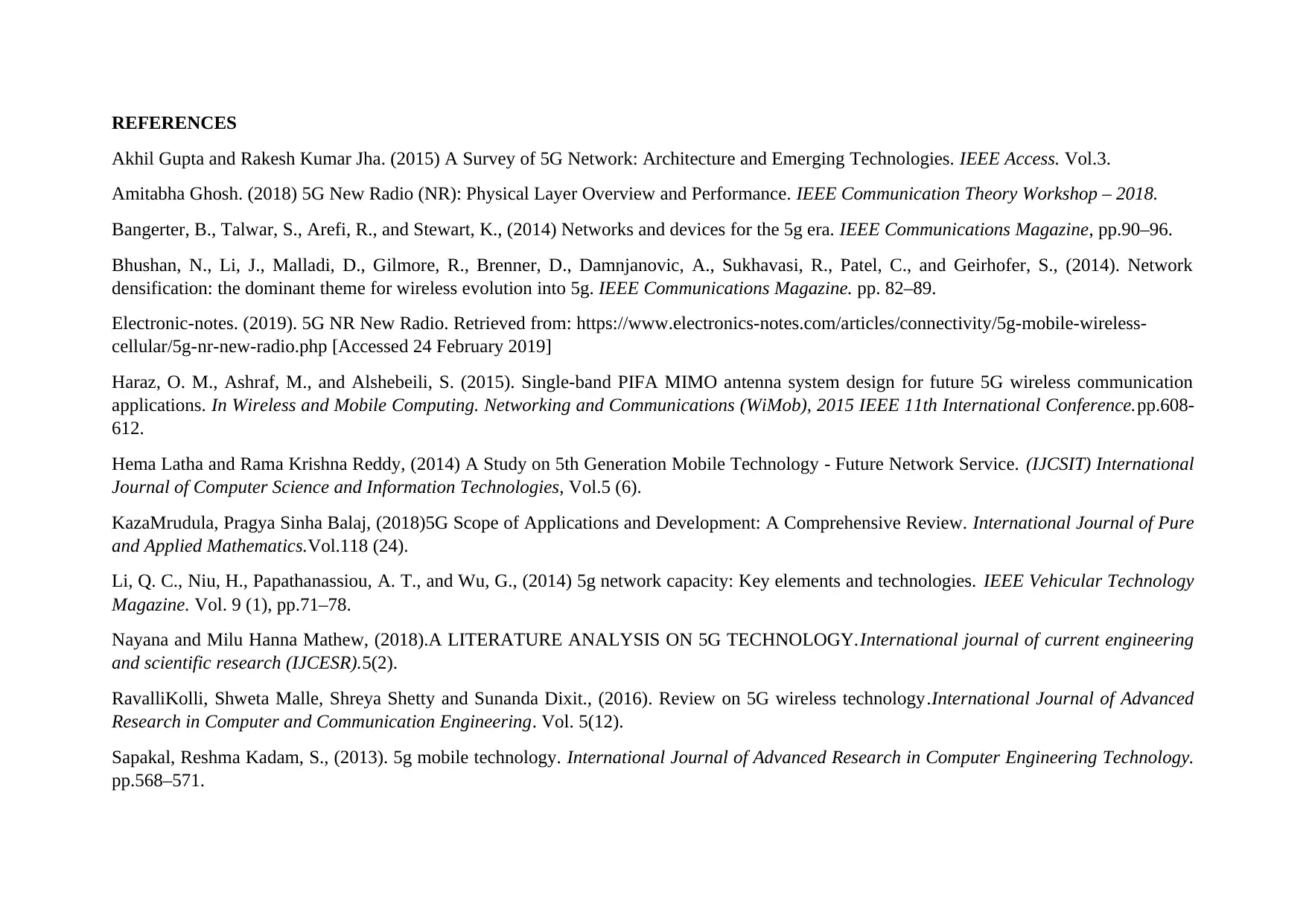
REFERENCES
Akhil Gupta and Rakesh Kumar Jha. (2015) A Survey of 5G Network: Architecture and Emerging Technologies. IEEE Access. Vol.3.
Amitabha Ghosh. (2018) 5G New Radio (NR): Physical Layer Overview and Performance. IEEE Communication Theory Workshop – 2018.
Bangerter, B., Talwar, S., Arefi, R., and Stewart, K., (2014) Networks and devices for the 5g era. IEEE Communications Magazine, pp.90–96.
Bhushan, N., Li, J., Malladi, D., Gilmore, R., Brenner, D., Damnjanovic, A., Sukhavasi, R., Patel, C., and Geirhofer, S., (2014). Network
densification: the dominant theme for wireless evolution into 5g. IEEE Communications Magazine. pp. 82–89.
Electronic-notes. (2019). 5G NR New Radio. Retrieved from: https://www.electronics-notes.com/articles/connectivity/5g-mobile-wireless-
cellular/5g-nr-new-radio.php [Accessed 24 February 2019]
Haraz, O. M., Ashraf, M., and Alshebeili, S. (2015). Single-band PIFA MIMO antenna system design for future 5G wireless communication
applications. In Wireless and Mobile Computing. Networking and Communications (WiMob), 2015 IEEE 11th International Conference.pp.608-
612.
Hema Latha and Rama Krishna Reddy, (2014) A Study on 5th Generation Mobile Technology - Future Network Service. (IJCSIT) International
Journal of Computer Science and Information Technologies, Vol.5 (6).
KazaMrudula, Pragya Sinha Balaj, (2018)5G Scope of Applications and Development: A Comprehensive Review. International Journal of Pure
and Applied Mathematics.Vol.118 (24).
Li, Q. C., Niu, H., Papathanassiou, A. T., and Wu, G., (2014) 5g network capacity: Key elements and technologies. IEEE Vehicular Technology
Magazine. Vol. 9 (1), pp.71–78.
Nayana and Milu Hanna Mathew, (2018).A LITERATURE ANALYSIS ON 5G TECHNOLOGY.International journal of current engineering
and scientific research (IJCESR).5(2).
RavalliKolli, Shweta Malle, Shreya Shetty and Sunanda Dixit., (2016). Review on 5G wireless technology.International Journal of Advanced
Research in Computer and Communication Engineering. Vol. 5(12).
Sapakal, Reshma Kadam, S., (2013). 5g mobile technology. International Journal of Advanced Research in Computer Engineering Technology.
pp.568–571.
Akhil Gupta and Rakesh Kumar Jha. (2015) A Survey of 5G Network: Architecture and Emerging Technologies. IEEE Access. Vol.3.
Amitabha Ghosh. (2018) 5G New Radio (NR): Physical Layer Overview and Performance. IEEE Communication Theory Workshop – 2018.
Bangerter, B., Talwar, S., Arefi, R., and Stewart, K., (2014) Networks and devices for the 5g era. IEEE Communications Magazine, pp.90–96.
Bhushan, N., Li, J., Malladi, D., Gilmore, R., Brenner, D., Damnjanovic, A., Sukhavasi, R., Patel, C., and Geirhofer, S., (2014). Network
densification: the dominant theme for wireless evolution into 5g. IEEE Communications Magazine. pp. 82–89.
Electronic-notes. (2019). 5G NR New Radio. Retrieved from: https://www.electronics-notes.com/articles/connectivity/5g-mobile-wireless-
cellular/5g-nr-new-radio.php [Accessed 24 February 2019]
Haraz, O. M., Ashraf, M., and Alshebeili, S. (2015). Single-band PIFA MIMO antenna system design for future 5G wireless communication
applications. In Wireless and Mobile Computing. Networking and Communications (WiMob), 2015 IEEE 11th International Conference.pp.608-
612.
Hema Latha and Rama Krishna Reddy, (2014) A Study on 5th Generation Mobile Technology - Future Network Service. (IJCSIT) International
Journal of Computer Science and Information Technologies, Vol.5 (6).
KazaMrudula, Pragya Sinha Balaj, (2018)5G Scope of Applications and Development: A Comprehensive Review. International Journal of Pure
and Applied Mathematics.Vol.118 (24).
Li, Q. C., Niu, H., Papathanassiou, A. T., and Wu, G., (2014) 5g network capacity: Key elements and technologies. IEEE Vehicular Technology
Magazine. Vol. 9 (1), pp.71–78.
Nayana and Milu Hanna Mathew, (2018).A LITERATURE ANALYSIS ON 5G TECHNOLOGY.International journal of current engineering
and scientific research (IJCESR).5(2).
RavalliKolli, Shweta Malle, Shreya Shetty and Sunanda Dixit., (2016). Review on 5G wireless technology.International Journal of Advanced
Research in Computer and Communication Engineering. Vol. 5(12).
Sapakal, Reshma Kadam, S., (2013). 5g mobile technology. International Journal of Advanced Research in Computer Engineering Technology.
pp.568–571.
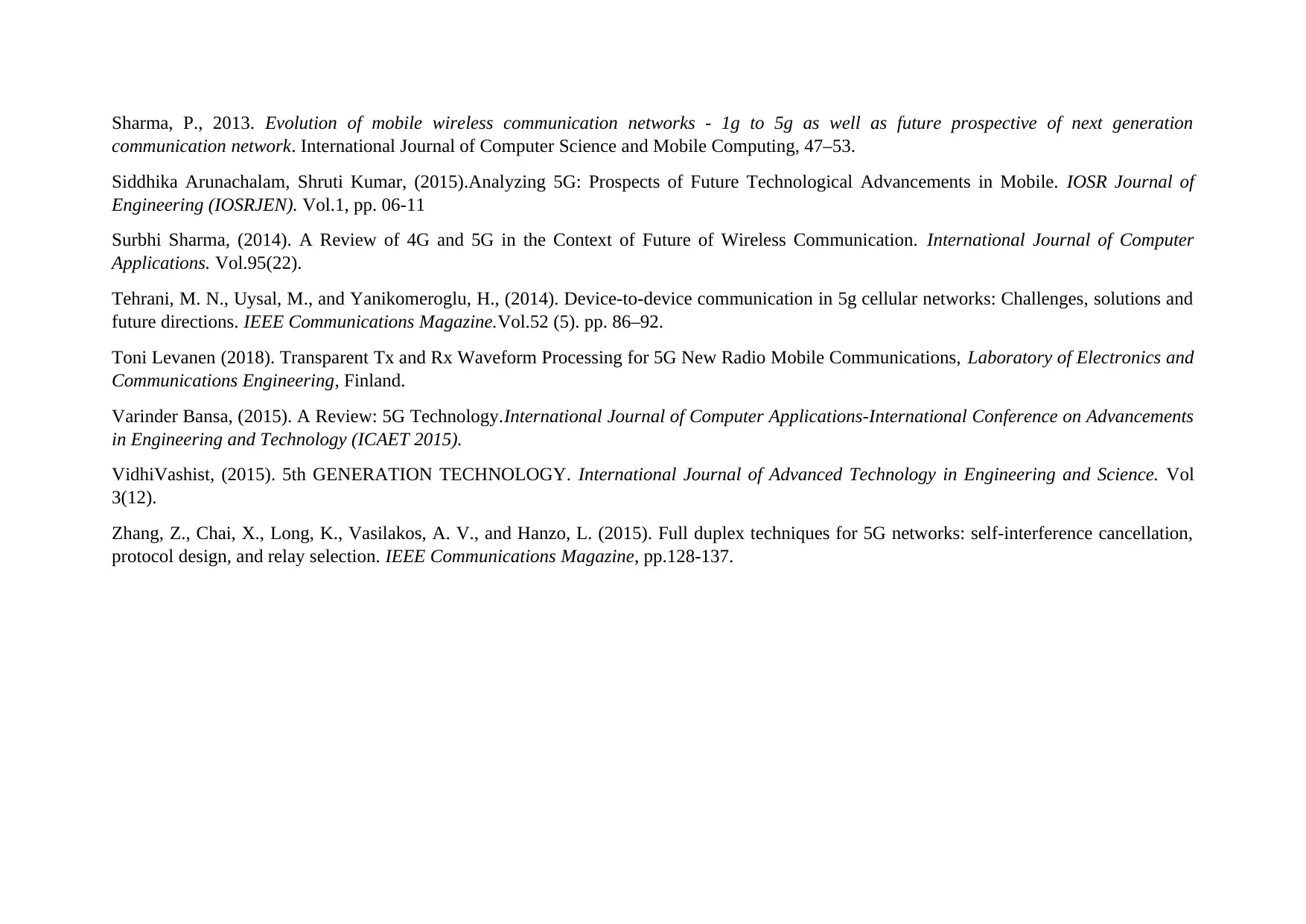
Sharma, P., 2013. Evolution of mobile wireless communication networks - 1g to 5g as well as future prospective of next generation
communication network. International Journal of Computer Science and Mobile Computing, 47–53.
Siddhika Arunachalam, Shruti Kumar, (2015).Analyzing 5G: Prospects of Future Technological Advancements in Mobile. IOSR Journal of
Engineering (IOSRJEN). Vol.1, pp. 06-11
Surbhi Sharma, (2014). A Review of 4G and 5G in the Context of Future of Wireless Communication. International Journal of Computer
Applications. Vol.95(22).
Tehrani, M. N., Uysal, M., and Yanikomeroglu, H., (2014). Device-to-device communication in 5g cellular networks: Challenges, solutions and
future directions. IEEE Communications Magazine.Vol.52 (5). pp. 86–92.
Toni Levanen (2018). Transparent Tx and Rx Waveform Processing for 5G New Radio Mobile Communications, Laboratory of Electronics and
Communications Engineering, Finland.
Varinder Bansa, (2015). A Review: 5G Technology.International Journal of Computer Applications-International Conference on Advancements
in Engineering and Technology (ICAET 2015).
VidhiVashist, (2015). 5th GENERATION TECHNOLOGY. International Journal of Advanced Technology in Engineering and Science. Vol
3(12).
Zhang, Z., Chai, X., Long, K., Vasilakos, A. V., and Hanzo, L. (2015). Full duplex techniques for 5G networks: self-interference cancellation,
protocol design, and relay selection. IEEE Communications Magazine, pp.128-137.
communication network. International Journal of Computer Science and Mobile Computing, 47–53.
Siddhika Arunachalam, Shruti Kumar, (2015).Analyzing 5G: Prospects of Future Technological Advancements in Mobile. IOSR Journal of
Engineering (IOSRJEN). Vol.1, pp. 06-11
Surbhi Sharma, (2014). A Review of 4G and 5G in the Context of Future of Wireless Communication. International Journal of Computer
Applications. Vol.95(22).
Tehrani, M. N., Uysal, M., and Yanikomeroglu, H., (2014). Device-to-device communication in 5g cellular networks: Challenges, solutions and
future directions. IEEE Communications Magazine.Vol.52 (5). pp. 86–92.
Toni Levanen (2018). Transparent Tx and Rx Waveform Processing for 5G New Radio Mobile Communications, Laboratory of Electronics and
Communications Engineering, Finland.
Varinder Bansa, (2015). A Review: 5G Technology.International Journal of Computer Applications-International Conference on Advancements
in Engineering and Technology (ICAET 2015).
VidhiVashist, (2015). 5th GENERATION TECHNOLOGY. International Journal of Advanced Technology in Engineering and Science. Vol
3(12).
Zhang, Z., Chai, X., Long, K., Vasilakos, A. V., and Hanzo, L. (2015). Full duplex techniques for 5G networks: self-interference cancellation,
protocol design, and relay selection. IEEE Communications Magazine, pp.128-137.
1 out of 12
Related Documents
Your All-in-One AI-Powered Toolkit for Academic Success.
+13062052269
info@desklib.com
Available 24*7 on WhatsApp / Email
![[object Object]](/_next/static/media/star-bottom.7253800d.svg)
Unlock your academic potential
© 2024 | Zucol Services PVT LTD | All rights reserved.




